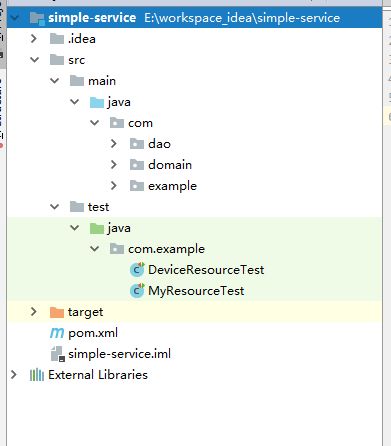一.第一个Java RESTFul 服务
本节讲述基于JavaSE环境的Jersey 官文文档中提供的示例simple-service,并在此基础上扩展自定义的RESTFul 资源服务
1.1 环境准备
准备开发RESTFul 服务的环境 包括JDK Maven 和 IDEA
1.2 创建服务
1.从Maven 原型创建项目
Jersey 官方文档中的提供的例子simple-service 是一个Maven 原型项目,在控制台执行如下命令来生成我们想要的simole-service 项目,项目的存储路径可以自行选择
mvn archetype:generate -DarchetypeArtifactId=jersey-quickstart-grizzly2 -DarchetypeGroupId=org.glassfish.jersey.archetypes
-DinteractiveMode=false -DgroupId=com.example -DartifactId=simple-service -Dpackage=com.example -DarchetypeVersion=2.26
控制台命令成功执行之后,会在当前目录下创建simple-service目录。该目录包含了simple-service 项目的源代码
2.项目入口类分析
因为这是一个javaSE项目 所以需要一个入口类来启动服务并加载项目资源
package com.example;
import org.glassfish.grizzly.http.server.HttpServer;
import org.glassfish.jersey.grizzly2.httpserver.GrizzlyHttpServerFactory;
import org.glassfish.jersey.jdkhttp.JdkHttpServerFactory;
import org.glassfish.jersey.server.ResourceConfig;
import org.glassfish.jersey.simple.SimpleContainer;
import org.glassfish.jersey.simple.SimpleContainerFactory;
import java.io.IOException;
import java.net.URI;
/**
* Main class.
*
*/
public class Main {
// 服务器路径
public static final String BASE_URI = "http://localhost:8080/myapp/";
public static HttpServer startServer() {
// 加载资源
final ResourceConfig rc = new ResourceConfig().packages("com.example");
//创建和启动grizzly http 服务器
return GrizzlyHttpServerFactory.createHttpServer(URI.create(BASE_URI), rc);
}
public static com.sun.net.httpserver.HttpServer startServerByHTTPServer(){
final ResourceConfig rc = new ResourceConfig().packages("com.example");
return JdkHttpServerFactory.createHttpServer(URI.create(BASE_URI),rc);
}
/**
* 启动服务器
* @param args
* @throws IOException
*/
public static void main(String[] args) throws IOException {
final HttpServer server = startServer();
System.out.println(String.format("Jersey app started with WADL available at "
+ "%sapplication.wadl\nHit enter to stop it...", BASE_URI));
System.in.read();
server.stop();
}
}
Main类定义了HTTP服务器的路径即http://localhost:8080/myapp/ .在其构造器中映射了源代码所在的包名为 new ResourceConfig().packages("com.example"); 这意味着 服务器启动时会自动扫描该包下的所有类,根据该包中所含类的REST资源路径的注解,在内存中做好映射。这样一来客户端请求指定路径后服务端就可以根据映射,分派请求给相应的资源类实例的相应的方法了
2.资源类分析
套用Web 开发环境中典型的三层逻辑,资源类位于逻辑分层的最高层----API层 其下为Service 层和数据访问层,在三层逻辑中,API层用于对外公布接口
package com.example;
import javax.ws.rs.GET;
import javax.ws.rs.Path;
import javax.ws.rs.Produces;
import javax.ws.rs.core.MediaType;
/**
* Root resource (exposed at "myresource" path)
*/
@Path("myresource")
public class MyResource {
/**
* Method handling HTTP GET requests. The returned object will be sent
* to the client as "text/plain" media type.
*
* @return String that will be returned as a text/plain response.
*/
@GET
@Produces(MediaType.TEXT_PLAIN)
public String getIt() {
return "Got it!";
}
}
1.3 扩展服务
1.增加设备实体类(在com.domain 包下新建一个Device 类)
package com.domain;
import javax.xml.bind.annotation.XmlAttribute;
import javax.xml.bind.annotation.XmlRootElement;
@XmlRootElement(name="device")
public class Device {
private String deviceIP;
private int deviceStatus;
public Device(){
}
public Device(String deviceIP){
this.deviceIP = deviceIP;
}
public String getDeviceIP() {
return deviceIP;
}
public void setDeviceIP(String deviceIP) {
this.deviceIP = deviceIP;
}
@XmlAttribute
public int getDeviceStatus() {
return deviceStatus;
}
public void setDeviceStatus(int deviceStatus) {
this.deviceStatus = deviceStatus;
}
}
package com.dao;
import com.domain.Device;
import com.sun.org.apache.bcel.internal.generic.RETURN;
import java.util.concurrent.ConcurrentHashMap;
public class DeviceDao {
private ConcurrentHashMap fakeDB = new ConcurrentHashMap<>();
public DeviceDao(){
fakeDB.put("127.0.0.1",new Device("127.0.0.1"));
fakeDB.put("192.168.4.74",new Device("192.168.4.74"));
}
public Device getDevice(String IP){
return fakeDB.get(IP);
}
public Device updateDevice(Device device){
String IP = device.getDeviceIP();
fakeDB.put(IP,device);
return fakeDB.get(IP);
}
}
该类标注了JAXB 标准定义的@XmlRootElement 和 @XmlAttribute 注解 以便将Device类和XML格式的设备数据相互转化并在服务器和客户端之间传输
2.增加设备资源类
创建了设备实体类之后,我们需要一个资源来公布设备的REST API
package com.example;
import com.dao.DeviceDao;
import com.domain.Device;
import javax.ws.rs.*;
import javax.ws.rs.core.MediaType;
import javax.ws.rs.core.MultivaluedMap;
import java.util.List;
import java.util.Map;
@Path(value = "device")
public class DeviceResource {
private DeviceDao deviceDao;
public DeviceResource(){
deviceDao = new DeviceDao();
}
@GET
@Produces({MediaType.APPLICATION_JSON,MediaType.APPLICATION_XML})
public Device get(@QueryParam("ip") final String deviceIP){
Device device = null;
if (deviceIP != null){
device = deviceDao.getDevice(deviceIP);
}
return device;
}
@PUT
@Produces({MediaType.APPLICATION_JSON,MediaType.APPLICATION_XML})
public Device put(final Device device){
Device result = null;
if (device != null){
result = deviceDao.updateDevice(device);
}
return result;
}
}
@PUT是标注处理put请求 @Produces({MediaType.APPLICATION_JSON,MediaType.APPLICATION_XML}) 是标注返回实体的类型,支持JSON 和XML 数据格式
3.测试和运行服务
package com.example;
import com.domain.Device;
import org.glassfish.grizzly.http.server.HttpServer;
import org.junit.After;
import org.junit.Assert;
import org.junit.Before;
import org.junit.Test;
import javax.ws.rs.client.Client;
import javax.ws.rs.client.ClientBuilder;
import javax.ws.rs.client.Entity;
import javax.ws.rs.client.WebTarget;
import javax.ws.rs.core.MediaType;
import java.util.HashMap;
import java.util.Map;
public class DeviceResourceTest {
private HttpServer httpServer;
private WebTarget target;
@Before
public void setUp() throws Exception{
httpServer = Main.startServer();
final Client client = ClientBuilder.newClient();
target = client.target(Main.BASE_URI);
}
@After
public void tearDown() throws Exception{
httpServer.shutdown();
}
@Test
public void testGetDevice(){
final String targetIP = "127.0.0.1";
final Device device = target.path("device").queryParam("ip",targetIP).request().get(Device.class);
Assert.assertEquals(targetIP,device.getDeviceIP());
}
@Test
public void testPutDevice(){
Device device = new Device();
device.setDeviceIP("192.168.5.5");
device.setDeviceStatus(2);
Entity entity = Entity.entity(device, MediaType.APPLICATION_XML_TYPE);
Device result = target.path("device").request().put(entity,Device.class);
Assert.assertEquals("192.168.5.5",result.getDeviceIP());
}
@Test
public void testPost(){
Device device = new Device();
device.setDeviceIP("192.168.5.5");
device.setDeviceStatus(2);
Entity entity = Entity.entity(device, MediaType.TEXT_PLAIN_TYPE);
String result = target.path("device").request().post(entity,String.class);
Assert.assertEquals(result,"SUCCESS");
}
}
打开控制台 在项目的目录下运行 :mvn clean test 如果测试通过 即断言验证成功
二.第一个Servlet 容器 服务
1.1 创建和分析Web 服务
simple-service-webapp项目也是Jersey官方文档中的例子,同样是个Maven原型
mvn archetype:generate -DarchetypeArtifactId=jersey-quickstart-webapp
-DarchetypeGroupId=org.glassfish.jersey.archetypes -DinteractiveMode=false
-DgroupId=com.example -DartifactId=simple-service-webapp -Dpackage=com.example
-DarchetypeVersion=2.26
在 控制台下 执行该命令 就可以获取源代码了
通过maven 将项目打包 部署至tomcat运行即可
三.REST 服务类型
1.REST 服务分为四种类型
- 类型一:当服务中没有Application 子类时 容器会查找Servlet的子类来做入口,如果Servlet 的子类也不存在,则REST服务类型为类型一
- 类型二:当服务类中没有Application 子类,但存在Servlet的子类时,则REST 服务类型为类型二
- 类型三:服务中定义了Application 的子类 而且这个Application 的子类使用了@ApplicationPath注解 则REST服务类型为类型三
- 类型四:如果服务中定义了Application 的子类 但是这个Application 的子类没有使用@ApplicationPath注解 则REST服务类型为类型四
2.REST 服务类型一
类型一相应的逻辑是服务中同时不存在Application的子类和Servlet的子类,因此需要为REST服务动态生成一个名为javax.ws.rs.core.Application 的Servlet 实例,并自动探测匹配资源,需要在 web.xml 下配置
Jersey Web Application
org.glassfish.jersey.servlet.ServletContainer
jersey.config.server.provider.packages
com.example
1
Jersey Web Application
/webapi/*
3.REST 服务类型二
类型二 相应的逻辑不存在Application 的子类 ,但存在Servlet的子类,因此需要有个类继承自HttpServlet
package com.example;
import javax.servlet.annotation.WebInitParam;
import javax.servlet.annotation.WebServlet;
import org.glassfish.jersey.servlet.ServletContainer;
/**
* 类型二:不存在Application子类,存在Servlet的子类,ServletContainer 继承自HttpServlet
*/
@WebServlet(initParams = @WebInitParam(name = "jersey.config.server.provider.packages", value = "com.example"),
urlPatterns = "/webapi/*",
loadOnStartup = 1)
public class AirServlet extends ServletContainer {
private static final long serialVersionUID = 1L;
}
四.REST 服务类型三
类型三 相应的逻辑存在Application 的子类并且定义了@ApplicationPath 注解
package com.example;
import javax.ws.rs.ApplicationPath;
import org.glassfish.jersey.server.ResourceConfig;
@ApplicationPath("/webapi/*")
public class AirResourceConfig extends ResourceConfig {
public AirResourceConfig() {
packages("com.example");
}
}
五.REST 服务类型四
类型四 不存在Servlet 子类 也不存在或者不允许使用@ApplicationPath 注解
package com.example;
import java.util.HashSet;
import java.util.Set;
import javax.ws.rs.core.Application;
public class AirApplication extends Application {
@Override
public Set> getClasses() {
final Set> classes = new HashSet>();
classes.add(MyResource.class);
return classes;
}
}


